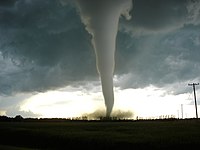
Photo from wikipedia
Abstract: A 15-year (1997–2011) climatology of dust events at the NASA DFRC in Lancaster, California, USA, was performed to evaluate how the extratropical systems were associated with dust storms over… Click to show full abstract
Abstract: A 15-year (1997–2011) climatology of dust events at the NASA DFRC in Lancaster, California, USA, was performed to evaluate how the extratropical systems were associated with dust storms over this region. For this study, we collected meteorological data for Edwards Air Force Base (EAFB) in Lancaster, California, which is very close to NASA DFRC, from wunderground.com, National Centers for Environmental Prediction (NCEP)/North American Regional Reanalysis (NARR), NCEP/Hydro-meteorological Prediction Center/National Weather Service (NWS), and Unisys analyses. We find that the dust events were associated with the development of a deep convective boundary layer, turbulence kinetic energy (TKE) ≥3 J/kg, a deep unstable lapse rate layer, a wind speed above the frictional threshold wind speed necessary to ablate dust from the surface (≥7.3 m/s), a presence of a cold trough above the deep planetary boundary layer (PBL), a strong cyclonic jet, an influx of vertical sensible heat from the surrounding area, and a low volumetric soil moisture fraction <0.3. The annual mean number of dust events, their mean duration, and the unit duration per number of event for each visibility range, when binned as <11.2 km, <8 km, <4.8 km, <1.6 km, and <1 km were calculated. The visibility range values were positively correlated with the annual mean number of dust events, duration of dust events, and the ratio of duration of dust events. The percentage of the dust events by season shows that most of the dust events occurred in autumn (44.7%), followed by spring (38.3%), and equally in summer and winter with these seasons each accounting for 8.5% of events. This study also shows that the summer had the highest percentage (10%) of the lowest visibility condition (<1 km) followed by autumn (2%). Neither of the other two seasons—winter and spring—experienced such a low visibility condition during the entire dust events over 15 years. Winter had the highest visibility (<11.2 km) percentage, which was 67% followed by spring (55%). Wind speed increasing to a value within the range of 3.6–11 m/s was typically associated with the dust events.
Journal Title: Climate
Year Published: 2017
Link to full text (if available)
Share on Social Media: Sign Up to like & get
recommendations!